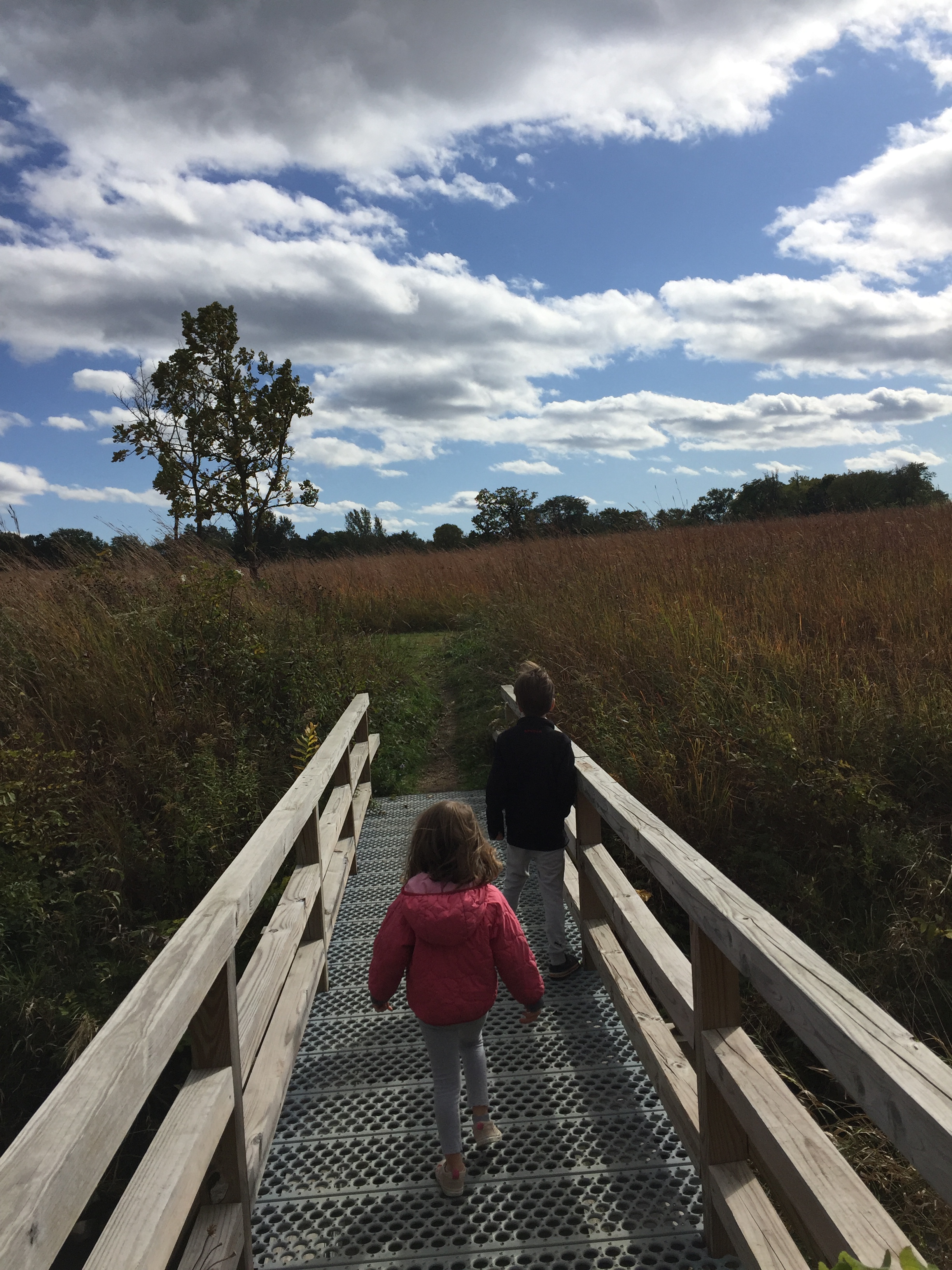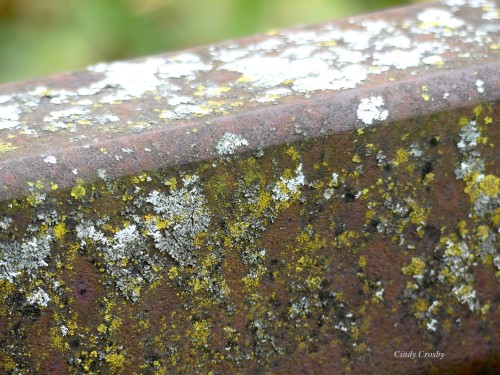“The world is full of obvious things which nobody by any chance ever observes.” — Sherlock Holmes
*****
A whisper of frost is in the air, with the hard slam of a freeze not far behind.

Cold weather’s scythe hangs over the prairie. In response, the tallgrass flings itself into October, showcasing all the delights that autumn has to offer. So much to explore. So much to discover.
Let’s go look.

The tallgrass hums along, closing up shop, its seed production mostly complete.

Smooth Solomon’s seal leaves cling to their bright green draining away. Their fruits show the turn of the season.

Lichens colonize the metal bridge which leads to the prairie, splotching it with color.

Nodding ladies’ tresses orchids, latecomers to the seed production party, throw out their final blooms. Their mild fragrance has vanished into the cold.

Big bluestem and Indian grass stitch the prairie with slender threads of subtle color.

Pale prairie plantain trims the landscape with seed lace and leaf rickrack.

Lashes of goldenrod’s foamy seeds decorate the edges.

Late figwort throws its seed pearls into the mix.

Little bluestem launches its colorfest; you can find swatches of it patching the prairie in a rust-hued blur.

Pincushions of pasture thistle send silky seed-notes into the air.

Joy in the aggregate; beauty in the singular.

Dragonfly season is mostly shot. That said, six green darners hover overhead, delayed, perhaps, in joining the migration masses. A lone American rubyspot damselfly clings to reed canary grass over Willoway Brook. Despite the name, this particular insect is mostly colorless on a gray, windy, October day.

The sounds of the season have gradually changed from summer to autumn in the Chicago region.

Walking Fermilab’s interpretive trail in high winds this weekend, I hear the scraping of prairie dock leaves, still morphing between juiced and brittle. The hiss of big bluestem and Indian grass; rusting leaves and switchgrass stems rubbing together. The sound is rain patter on a roof, or hot oil in sizzling in a skillet. What do you think?
This prairie dock leaf’s venation stands out like a topo map; all mountains and rivers and ridges.

Nearby, the rosette galls are October’s last bouquet; beauty in the face of rampant decay.

Even the Queen Anne’s lace takes on a new persona in October. I hesitate to say it’s “beautiful” as we prairie stewards and volunteers work so hard to eradicate Queen Anne’s lace from our natural areas. And yet…

Among the lone trees that sprinkle the tallgrass, I hear unaccustomed chirps — the sounds of warblers moving south and sheltering here for a few hours. “Those confusing fall warblers” — an understatement, if ever there was one. Today, a few invasive starlings show up with the warbler crowd. These—at least—are easy to ID.

Although I’m not much good at identifying fall birds, I can identify a pair of sandhill cranes wading through a nearby wetland at Fermilab. Hard to miss.

Regal and comical at the same time. Seemingly impervious to the cold winds.

There’s so much to see in October on the prairie. So much grace and color. So many simple wonders.

So much to love.

It’s waiting for you.

*****
Sherlock Holmes, whose quote kicks off this post, was a fictional detective penned by British physician turned writer Sir Arthur Conan Doyle (1859-1930). “Holmes” first appeared in print in the late 1880’s. Doyle also wrote poetry, science fiction, fantasy, plays, and romance. Oddly enough, he also dabbled in architecture and designed a golf course and redesigned a hotel. Doyle, who had five children, died at 71; his last words were to his wife: “You are wonderful.” Now that’s sweet.
*****
All photos and video copyright Cindy Crosby except photo of children on bridge (courtesy Jennifer Buono): (top to bottom): stormy October skies over the Schulenberg Prairie, The Morton Arboretum, Lisle, IL; exploring the prairie, Schulenberg Prairie, The Morton Arboretum, Lisle, IL (Jennifer Buono, photographer); Illinois bundleflower (Desmanthus illinoensis), Schulenberg Prairie, The Morton Arboretum, Lisle, IL; smooth Solomon’s seal (Polygonatum commutatum), Schulenberg Prairie, The Morton Arboretum, Lisle, IL; unknown lichens on the bridge over Willoway Brook, Schulenberg Prairie, The Morton Arboretum, Lisle, IL; nodding ladies’ tresses orchids (Spiranthes cernua), Schulenberg Prairie, The Morton Arboretum, Lisle, IL; big bluestem (Andropogon gerardii) and Indian grass (Sorghastrum nutans), Schulenberg Prairie, The Morton Arboretum, Lisle, IL: pale Indian plantain (Arnoglossum atriplicifolium), Schulenberg Prairie, The Morton Arboretum, Lisle, IL; probably Canada goldenrod (Solidago canadensis) and pale Indian plantain (Arnoglossum atriplicifolium), Schulenberg Prairie, The Morton Arboretum, Lisle, IL; late figwort (Scrophularia marilandica), Schulenberg Prairie, The Morton Arboretum, Lisle, IL; little bluestem (Schizachyrium scoparium), Schulenberg Prairie, The Morton Arboretum, Lisle, IL; pasture thistles (Cirsium discolor), Schulenberg Prairie, The Morton Arboretum, Lisle, IL; pasture thistle (Cirsium discolor), Schulenberg Prairie, The Morton Arboretum, Lisle, IL; American rubyspot damselfly (Hetaerina americana), Schulenberg Prairie, The Morton Arboretum, Lisle, IL; Prairie Interpretive Trail in October, Fermilab Natural Areas, Batavia, IL; video of wind on the Prairie Interpretive Trail, Fermilab Natural Areas, Batavia, IL; prairie dock (Silphium terebinthinaceum), Prairie Interpretive Trail, Fermilab Natural Areas, Batavia, IL; goldenrod gall rosette, Prairie Interpretive Trail, Fermilab Natural Areas, Batavia, IL; Queen Anne’s lace (Daucus carota), Prairie Interpretive Trail, Fermilab Natural Areas, Batavia, IL; European starling (Sturnus vulgaris), Schulenberg Prairie, The Morton Arboretum, Lisle, IL; sandhill cranes (Antigone canadensis), Fermilab Natural Areas, Batavia, IL; sandhill crane (Antigone canadensis), Fermilab Natural Areas, Batavia, IL; woodland sunflower (Helianthus spp.), Interpretive Prairie Trail, Fermilab Natural Areas, Batavia, IL; possibly American hog-peanut vine (Amphicarpaea bracteata), Schulenberg Prairie, The Morton Arboretum, Lisle, IL; bench on the Schulenberg Prairie in October, The Morton Arboretum, Lisle, IL.
*****
Cindy’s nature writing class (online and in-person) begins Wednesday, October 16! Tomorrow is the last day to register —check it out here.
See more of Cindy’s speaking events and classes at www.cindycrosby.com

Ah another delightful Tuesday morning with Cindy. Thank you.
The Prairie here in FDL has been so wet I hardly get a chance to walk it. I maybe get to slosh through the wet, sometimes standing water, path. Just an occasional aster or last remaining goldenrod anymore. As you say the seed heads and dried leaves have a special fall wonder. The grasses are sensational. Late afternoon sun has the Indian grass dripping of molten gold. Big Blue still has fabulous intense red and green. Little Blue which pushed up lots of seed heads this year hasn’t exploded. I think the rain and maybe cold weather stopped the process. I was hoping for the waving fairyland. One year we laid in the path with Little Blue all around. It was like being in a moving cloud. Seems to only happen every now and then.
20 years of observing and the best I can do is know change is constant, surprising and wonderful.
Slowly I’m finding a balance, within me, between eyes that see what we need to do and the internal experience of being one with the Prairie. (Your s l o w down to a crawl and connect.) for awhile all I could see was how much we could, should do. It was disturbing. Now I am beginning to flow from one to the other seamlessly, while sauntering. Your writing and pictures have fueled that process. I hope others encounter the spirit in Prairie. Your Blog does that. Your beautiful.
Bill
LikeLiked by 2 people
Your note here is poetry, Bill! How lovely. I’m so grateful for your kind words, and especially, your beautiful observations of your prairie over two decades. Love the transition from “doing” to “being”. Thank you for the inspiration today… and thank you, as always, for reading and taking time to write. I feel more hopeful for the future because of people like you. — Cindy
LikeLike
Thank you for these emails. I love the quote!
Vickie Robertson Illinois Grand Prairie Master Naturalist in Bloomington
>
LikeLiked by 1 person
Thank YOU Vickie for taking time to read and to leave a comment. I appreciate all the good work master naturalists do in the world! Happy October! — Cindy 🙂
LikeLike
Thank you! My feelings also !
LikeLiked by 1 person
Barbara, it’s always nice to “meet” a kindred spirit through the blog. Enjoy the week,and thank you for taking time to drop me a note. — Cindy 🙂
LikeLike
I’ve looked at the Big Bluestem and Indiangrass image more times than I have fingers. The pastels are stunning in their soft subtlety and also the way they cross one another. The haze of Little Bluestem is just the kind of haze I like to live in. Magic!
Thanks again,.
LikeLiked by 1 person
Ed, you leave the nicest comments! Thank you for reading, and for commenting so specifically on the colors and little bluestem–it is such a stunning plant! Grateful. Hope you have a great week ahead! — Cindy 🙂
LikeLike